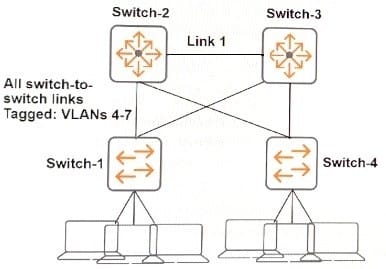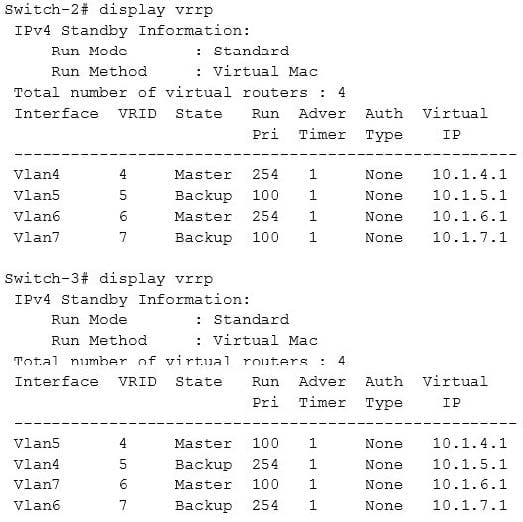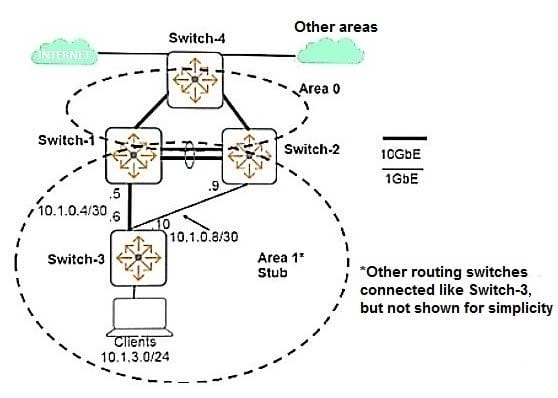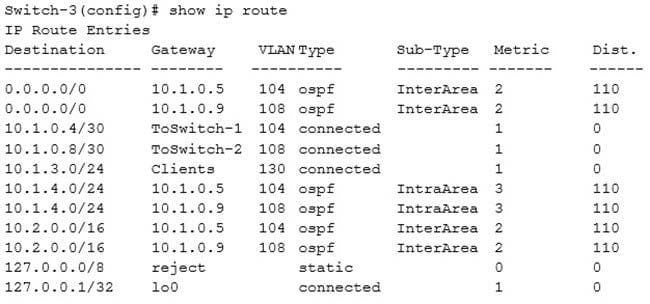Exam Details
Exam Code
:HPE6-A45Exam Name
:Implementing Aruba Campus Switching solutionsCertification
:HP CertificationsVendor
:HPTotal Questions
:168 Q&AsLast Updated
:Mar 22, 2025
HP HP Certifications HPE6-A45 Questions & Answers
-
Question 161:
Refer to the exhibits. Exhibit 1.

Exhibit 2.

The company wants to minimize congestion on Link 1.
Which spanning tree implementation meets this goal?
A. Instance 1 = VLANs 4-5 Instance 2 = VLANs 6-7 Switch 2 instance 1 priority = 0 Switch 2 instance 2 priority = 1 Switch 3 instance 1 priority = 1 Switch 3 instance 2 priority = 0
B. Instance 1 = VLANs 4,6 Instance 2 = VLANs 5,7 Switch 2 instance 1 priority = 0 Switch 2 instance 2 priority = 1 Switch 3 instance 1 priority = 1 Switch 3 instance 2 priority = 0
C. Instance 1 = VLANs 4,6 Instance 2 = VLANs 5,7 Switch 2 instance 1 priority = 0 Switch 2 instance 2 priority = 1 Switch 3 instance 1 priority = 0 Switch 3 instance 2 priority = 1
D. Instance 1 = VLANs 4-5 Instance 2 = VLANs 6-7 Switch 2 instance 1 priority = 0 Switch 2 instance 2 priority = 1 Switch 3 instance 1 priority = 0 Switch 3 instance 2 priority = 1
-
Question 162:
OSPF Area 1 has two ABRs. One ABR is configured with this range for Area 1: 10.10.0.0/16. The other ABR is not configured with a range for Area 1.
Which type of issue occurs due to this mismatch?
A. The ABRs create a discontinuous area and disrupt intra-area routing between devices within Area 1.
B. The ABR core would send Area 1 traffic destined to the other switch through an access switch.
C. The ABRs lose adjacency entirely and cannot route traffic between each other at all.
D. The ABRs lose adjacency in Area 1 and must route all traffic to each other through Area 0.
-
Question 163:
An AOS-Switch implements tunneled node.
Which benefit does the PAPI enhanced security key provide?
A. It validates the signature for firmware pushed to the switch dynamically.
B. It encrypts traffic sent and received by tunneled-node endpoints.
C. It authenticates control traffic between the switch and its Mobility Controller.
D. It provides an extra layer of authentication for endpoints on tunneled-node ports.
-
Question 164:
Refer to the exhibit.

A network administrator needs to deploy AOS-Switches that implement port-based tunneled node. Their
Aruba controller has IP address 10.1.10.5/24. The architect has assigned tunneled-node endpoints to VLAN 20.
What is one issue with the current configuration planned for VLAN 20 on the switch?
A. VLAN 20 must have GRE enabled on it.
B. VLAN 20 cannot have an IP address.
C. VLAN 20 must have an IP address in the same subnet as the controller.
D. VLAN 20 must not enable jumbo frames.
-
Question 165:
Refer to the exhibits.
Exhibit 1.

Exhibit 2.

The exhibits show the current operational state for routes on Switch-3. The company wants Switch-3 to prefer the link to Switch-1 over the link to Switch-2 for all intra-area, inter-area, and external traffic.
What can the network administrator do to achieve this goal?
A. Set the OSPF cost on VLAN 108 higher than 1 on Switch-2 and Switch-3.
B. Set the OSPF administrative distance on Switch-2 higher than 110.
C. Set the OSPF area type to normal on all of the switches in Area 1.
D. Set the cost in the OSPF Area 1 stub command higher than 1 on Switch-2.
-
Question 166:
Refer to the exhibit.

A network administrator sets up prioritization for an application that runs between Device 1 and Device 2.
However, the QoS for the application is not what the administrator expects.
How can the administrator check if the network infrastructure prioritizes traffic from Device 1 and Device 2?
A. Run a packet capture on Device 2, run the application, and look in the packet capture for a high value DSCP in the IP header.
B. Set up RMON alarms on the switches that trigger when a high number of packets are dropped. Then, run the application and check for the alarm.
C. Clear interface statistics on the switches. Then, run the application and check the interface queue statistics for the switch-to-switch links.
D. Run a packet capture on Device 1, run the application, and look in the packet capture for a high value DSCP in the IP header.
-
Question 167:
An administrator wants to ensure that an AOS-Switch forwards all traffic that it receives on interface 1 with high priority.
-Switches should also communicate the high priority to other switches across the traffic path.
-
The switch has type of service disabled.
-
The administrator plans to apply 802.1p priority 5 to interface 1.
What should the administrator check to ensure that the configuration will work properly?
A. Interface 1 receives traffic with a tag.
B. The AOS-Switch is configured to use eight queues.
C. The forwarding path for the traffic uses VLAN tags.
D. An 802.1p-to-DSCP map exists for priority 5.
-
Question 168:
Refer to the exhibit.

AOS-Switches will enforce 802.1X authentication on edge ports. The company has two RADIUS servers, which are meant to provide redundancy and load sharing of requests. The exhibit shows the planned RADIUS settings to deploy to the switches.
What should customers understand about this plan?
A. AOS switches do not support two RADIUS servers for redundancy, instead, a secondary authentication method is required.
B. Dynamic authentication is only permitted on one of the RADIUS servers and must be removed from the other.
C. Each RADIUS server must use a unique port number for the authentication and dynamic authorization port.
D. Each AOS-Switch will send all RADIUS requests to the first server on the list unless that server becomes unreachable.
Related Exams:
HP0-D15
Administering HP CloudSystem Matrix SolutionsHP0-D20
Architecting the HP Matrix Operating EnvironmentHP2-E56
Selling HP SMB SolutionsHP2-H88
Selling HP Business Personal Systems Hardware 2019HP2-I14
Selling HP Supplies 2020HP2-I15
Selling HP Business Personal Systems Hardware 2020HP2-I17
Selling HP Printing Hardware 2020HP2-I44
Selling HP Workstations 2022HP2-I73
Selling HP Retail and Hospitality Solutions 2024HP2-N51
HP Application Lifecycle Management 12.x Software
Tips on How to Prepare for the Exams
Nowadays, the certification exams become more and more important and required by more and more enterprises when applying for a job. But how to prepare for the exam effectively? How to prepare for the exam in a short time with less efforts? How to get a ideal result and how to find the most reliable resources? Here on Vcedump.com, you will find all the answers. Vcedump.com provide not only HP exam questions, answers and explanations but also complete assistance on your exam preparation and certification application. If you are confused on your HPE6-A45 exam preparations and HP certification application, do not hesitate to visit our Vcedump.com to find your solutions here.